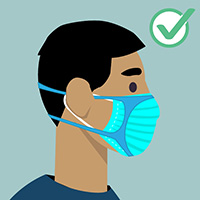
The addition of an elastic brace or double masking are highly successful methods that improve the performance of face masks against respiratory aerosols, according to a new study from the National Institute for Occupational Safety and Health (NIOSH).
Investigators tested the effectiveness of various mask modifications on humans and manikins against simulated coughs and exhalations using a source control measurement system. Medical masks without modification blocked 56% or more cough aerosols and 42% or more exhaled aerosols, they found.
In comparison, placing an elastic brace over a medical mask helped it to resist 95% or more of cough aerosols and 99% or more of exhaled aerosols. Double masking with a three-ply cloth mask on top of a medical mask, meanwhile, blocked 85% or more of cough aerosols and 91% or more of exhaled aerosols.
Earloop toggles, earloop straps, and knotting and tucking the mask also increased performance, although to a lesser degree. Crossing the ear loops or placing a bracket under the mask did not add additional protection, reported John D. Noti, Ph.D., of NIOSH, Centers for Disease Control and Prevention, Morgantown, WV.
“Our results show that the performance of face masks as source control devices depends upon both the ability of the mask material to filter aerosols and on how well the mask fits the wearer,” he and his colleagues wrote in a study published in the American Journal of Infection Control.
Poorly fitted masks may allow respiratory aerosols to escape through seal leaks, and fit modifications can improve the usefulness of these masks as source control, the researchers noted. Beyond protection against the SARS-CoV-2 virus, the findings “have broad applicability towards personal measures that can be taken to reduce the transmission of respirable infectious pathogens,” they concluded.
The CDC recommends wearing masks that are multi-layered, cover the nose and mouth, and form a tight seal against the face.




